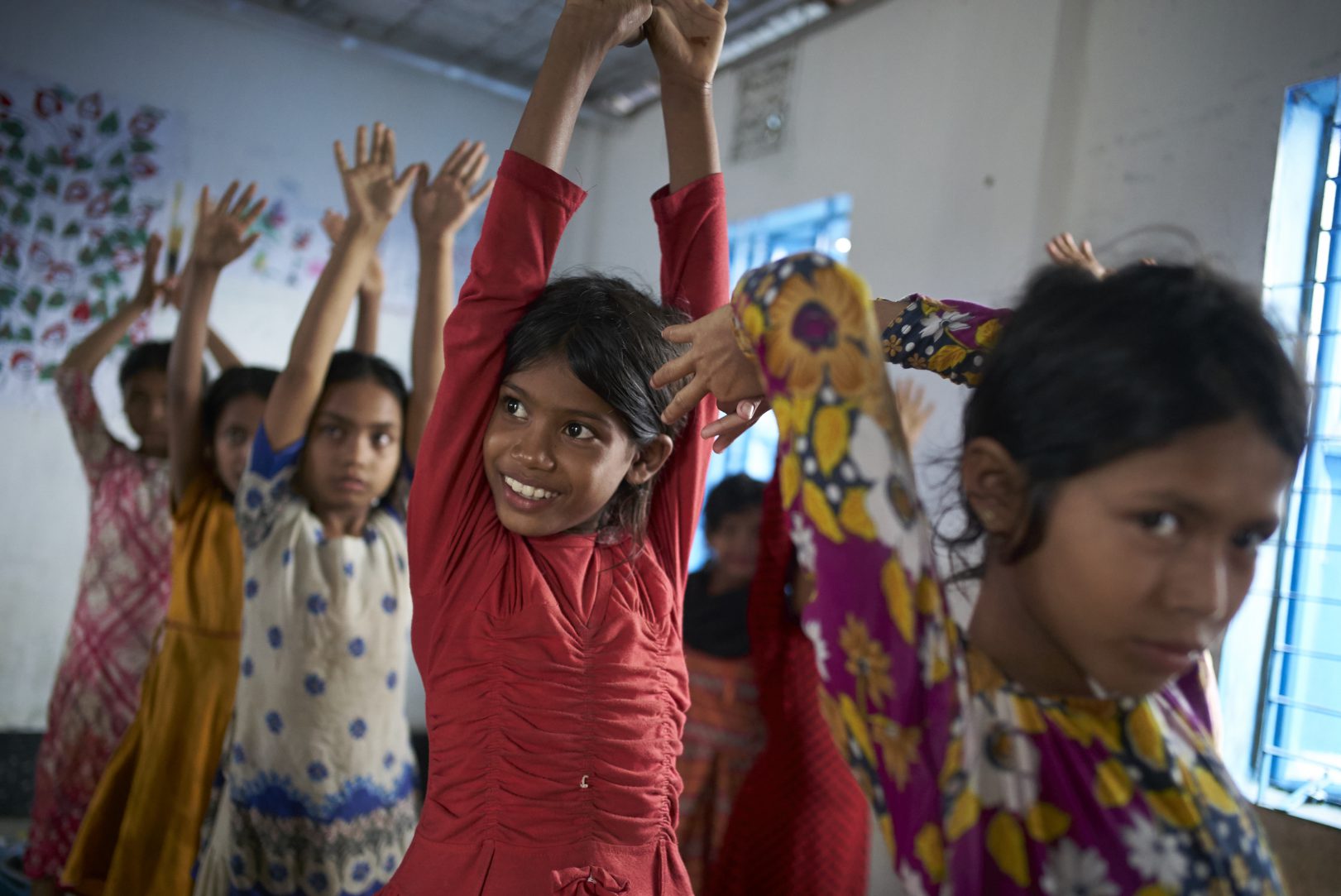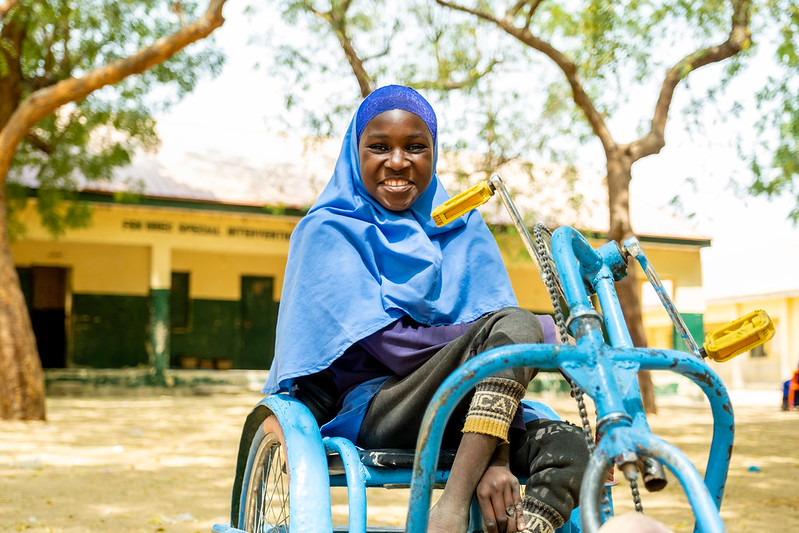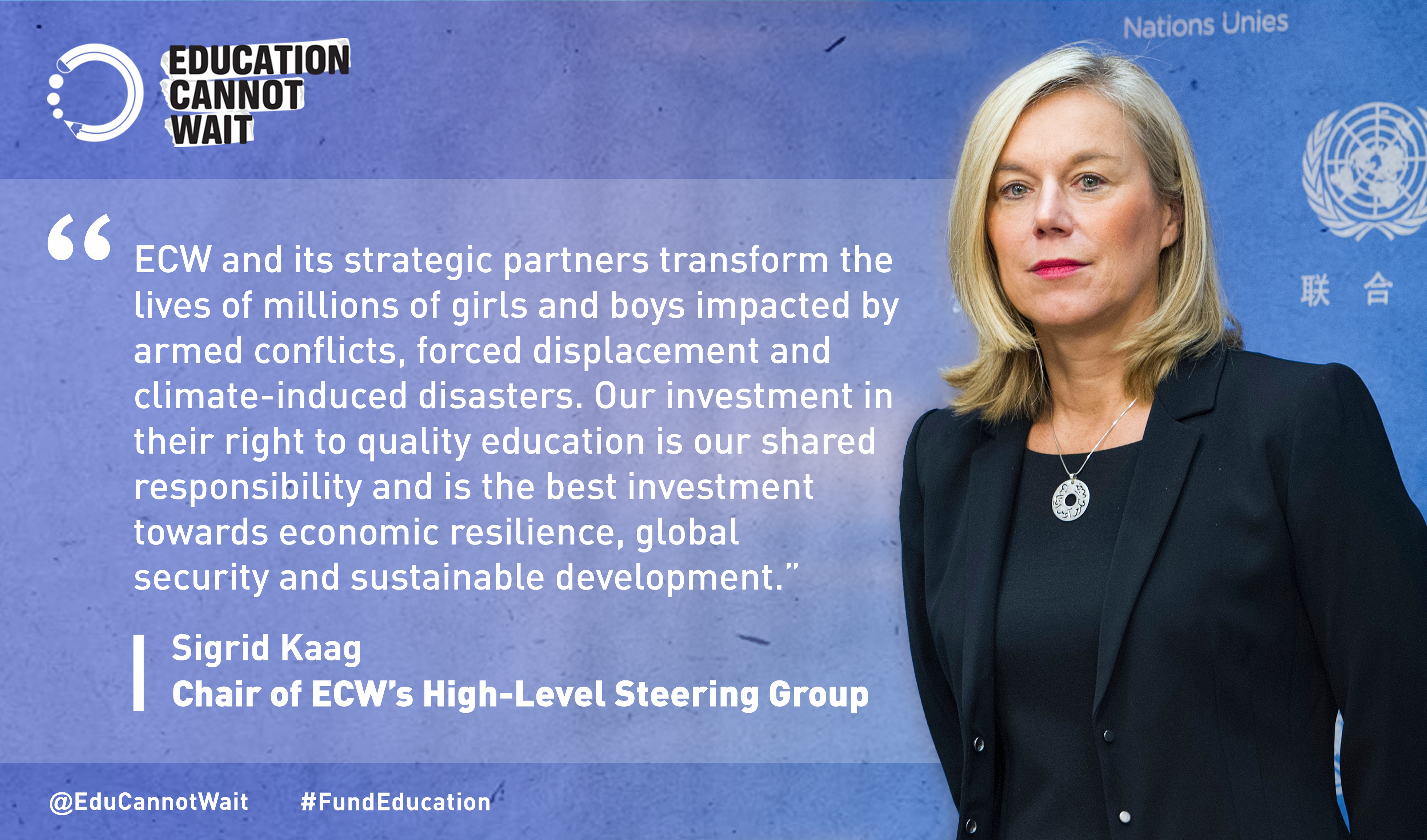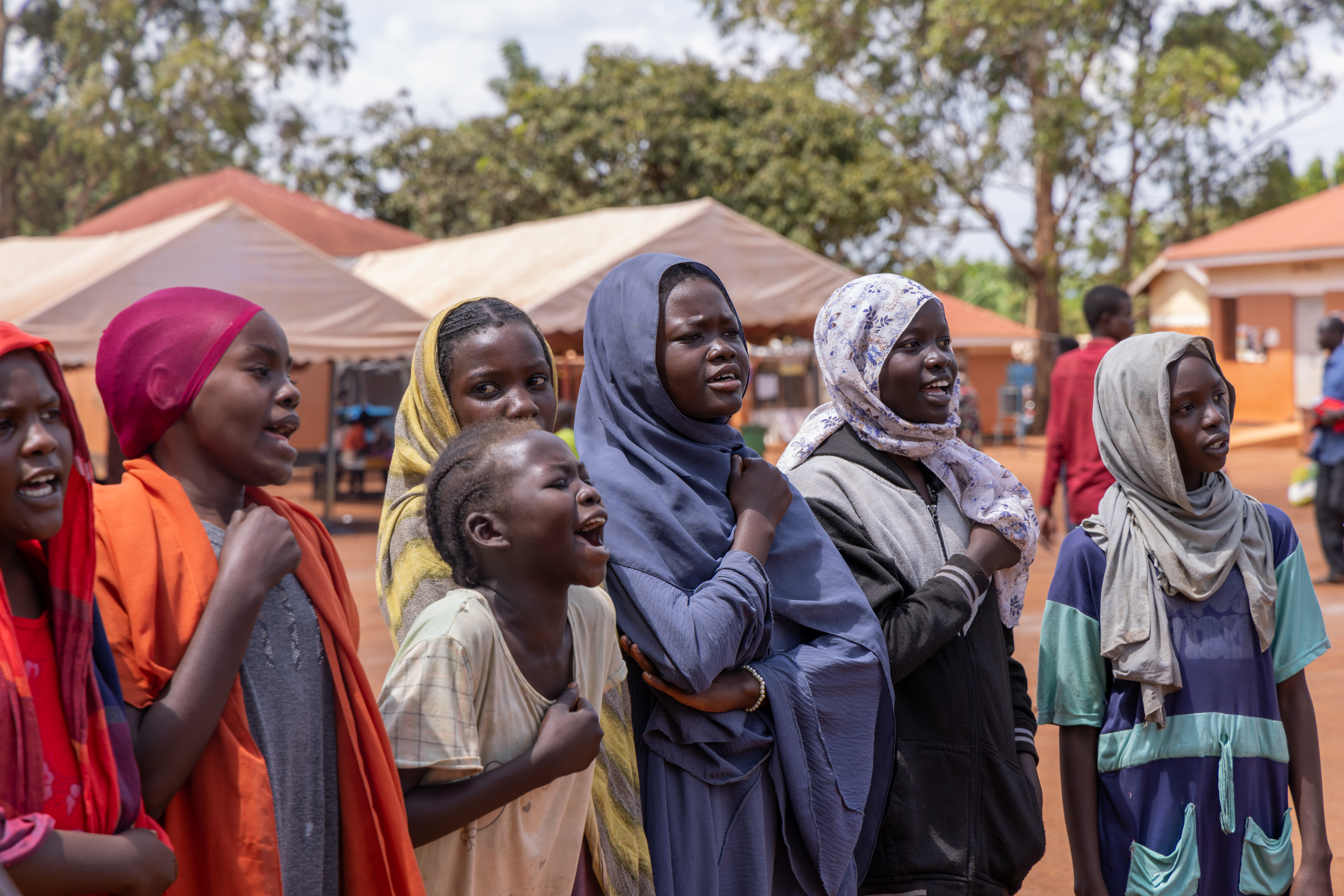Press Statement: an Estimated 70 Million Children Will Be Trapped in Humanitarian Emergencies in 2018

Global education is receiving less than half of needed funding, holding hostage the futures of millions of children
Gordon Brown, the United Nations Special Envoy for Global Education, speaking at the United Nation headquarters in New York said:
New evidence shows that the numbers of children trapped in humanitarian crises have reached an estimated 70 million, are expected to rise further in 2018 and the funding gap will grow, subjecting even more children to oppression and exploitation – forced marriage, child labour, and sexual trafficking – in the absence of opportunity and education.
I am calling today for a doubling of funding for humanitarian aid in education – more resources for the Global Partnership for Education (GPE) and the Education Cannot Wait fund (ECW) – and because there is no way we can deliver on the Sustainable Development Goals without a major shift in education funding, a new International Finance Facility dedicated to raising funds for education.
I have reviewed the data showing that almost 32 million of the estimated 70 million children trapped in humanitarian crises are currently forcibly displaced: 20 million children forced out of their homes within their own country plus more than 11 million refugees exiled from their countries. Child refugee numbers are rising not least because of three countries accounting for nearly half of refugees: Syria (with more than 2.6 million exiled), Afghanistan (more than 1.2 million), and South Sudan (over 900,000).
Of the 70 million children altogether, around 30 million have experienced violence or abuse. Children in conflict-affected countries are half as likely to complete lower-secondary school. And to take one example, reports show that over one-third of girls displaced from Syria were married before the age 18 – more than a three-fold increase in recent years.
While education has received more funding than ever in 2017 – over $700 million in funding for humanitarian emergencies and for refugees – the total remains low at just 3%.
Despite these startling trends, only three appeals this year received the full funding amount requested for education with 29 other crises receiving less than half of the funding needed. Today there are nine virtually forgotten education crises where less than 10% of the humanitarian funding for education was made available. These include the humanitarian appeals for Afghanistan (1.9%), Democratic Republic of the Congo (8%), Ethiopia (5.2%), Republic of Congo (0%), Dominica (7.3%), Madagascar (0%), Peru (9%), Bangladesh (6%) and Cuba (7%).
Most recently, we have appeals for Bangladesh for Rohingya refugees, for the Kasai region of the Democratic Republic of the Congo (DRC) and urgent needs from South Sudanese refugees flowing into Uganda.
We will start the year with 21 humanitarian response plans, four regional refugee response plans (Burundi, Nigeria, South Sudan and Syria) and five additional humanitarian appeals (Bangladesh, Burkina Faso, Democratic People’s Republic of Korea, Mauritania and Senegal).
But we cannot say these humanitarian challenges have come as a surprise. Nineteen crises have been running for five years or more, and three for nearly 20 years (Democratic Republic of the Congo, Sudan and Somalia). Yet in the DRC, for example, we reach only 8% of the 760,000 children in need. In Sudan, the humanitarian appeal for education stands at 1 in 10 children being supported. And in Somalia, less than half of education needs are met.
Today I want to show how in 2018 we can implement a promise of humanitarian aid that is comprehensive; based on a holistic assessment of needs and that includes education and in particular the needs of girls – and through education, their protection from sexual exploitation and abuse.
Before I make general conclusions let me emphasize how the urgent needs we have to address are being tackled:
Bangladesh
The response to the plight of Rohingya refugees has scaled up significantly since August, but children’s needs remain neglected. In August 2017, around 33,000 registered Rohingya refugees lived in two camps officially recognized by the Government of Bangladesh. Today, more than 600,000 people have fled to the country.
But while almost 60% of these refugees are children, we have only met 5% of the education needs – providing opportunity for 1 in 20 children. The Education Cannot Wait Fund has announced a catalytic investment to help get plans in place and target 30,000 refugee children, including 8,000 pre-school children.
Yasmine Sherif of Education Cannot Wait, and Kevin Watkins of Save the Children UK are working together and are in discussions with the government of Bangladesh. Kevin Watkins will visit later this month. The Final Report of the Advisory Commission on Rakhine State, chaired by Kofi Annan, requires us to offer equality of treatment to Rohingya children inside Myanmar.
Syria
While it is a great achievement that 1 million children affected by the Syria crisis are enrolled in formal or non-formal education programs in the region, we need to cater to all of the 5.4 million Syrians who have been forced to flee their homes. As of earlier this year, there were nearly 1.7 million registered school-age refugee children in five host countries of Turkey, Lebanon, Jordan, Iraq and Egypt. Nearly 60% are benefiting from education because of the measures taken by the international community, in partnership with the host countries. Yet 740,000 Syrian refugee children remain out of school in the region.
- Turkey hosts 850,000refugee children, with approximately 550,000 in school.
- Lebanon hosts 488,000 with approximately 220,000 benefiting from the “double-shift” school model.
The Inter-Agency Appeal has received about half of the overall $841 million in education funding requested. Unless we can now ensure multi-year, predictable support, the lost generation for Syrian youth will start to look like the lost century for Syrian youth. Our aim is to ensure donor countries, which have made promises of aid, deliver on this promise.
East Africa
It is estimated that 1.9 million South Sudanese people are internally displaced and 7.6 million are in need of humanitarian aid. There are now more than 2.1 million South Sudanese refugees, mostly women and children, who have fled to the neighboring countries of Central African Republic, Democratic Republic of the Congo, Ethiopia, Kenya, Sudan and Uganda.
As UN Special Envoy, I have been in touch with the Windle Trust International who has reported that South Sudan has the lowest secondary enrolment rates in the world – just 5% of young people go on to join secondary schools. Even worse, 5% is an average – for girls and in some states the percentage will be less than half that figure. A staggering 95% never get the chance to complete their basic education. Unless there is a concerted and sustained program of collective action, there is no likelihood of significant positive change in the next five years.
By the end of the year Uganda will host almost 1.5 million refugees. Out of these, an estimated one million are fleeing insecurity and violence in South Sudan. The remaining 500,000 are from the Democratic Republic of Congo, Burundi and Rwanda. And almost half of all in need are children under 18.
We have been working with Her Excellency Janet Museveni, First Lady of Uganda and Minister of Education on a response. A report prepared by Save the Children and launched during the Solidarity Summit showed that $132 million is needed to meet the basic education needs of children living in those areas. Education Cannot Wait, the Global Partnership for Education, Save The Children, the Inter-Agency Network for Education in Emergencies (INEE) and UNHCR have led a joint mission and are working on a collective response.
Palestine Refugees
One organisation stands on the front-line: UNRWA, the UN Agency for Palestine Refugees. Every single day, its 22,000 school principals, teachers and education specialists ensure the right to education of half a million Palestinian boys and girls in preserved areas.
And they do that in Aleppo, Homs or Damascus, in Syria, they do it in Jenin, Hebron and East Jerusalem, they do throughout Gaza, Lebanon and Jordan as well. They run 700 schools, where boys and girls learn Arabic, English, math, science, and engage passionately in a unique Human Rights training.
UNRWA is the single largest provider of education services for refugees across the entire UN system.
But today as they prepare for 2018 needs, they are still short of securing the ones for 2017. UNRWA will require US$ 444 million for 2018 – but it is still struggling to make up the US$ 61 million shortfall for 2017 which puts the continuation of education for 500,000 young people at risk in the region.
Progress and Way Forward
We will do everything to advance GPE’s replenishment effort in February of next year in support of Julia Gillard and Alice Albright’ endeavours.
I would also like to commend UNICEF, under the pioneering leadership for seven years of Anthony Lake, for the priority the organisation has placed on education in emergencies. This issue is rapidly becoming UNICEF’s single-biggest challenge and priority, comprising over a third (39%) of UNICEF’s $1.1 billion education budget.
I am pleased to announce the Education Cannot Wait fund, under the leadership of Yasmine Sherif, is making significant contributions to improving education in emergency situations.
One year only after ECW’s establishment, 13 countries have been selected to benefit from special funding support. ECW is currently working to promote access to quality education for 3.7 million children – of which 1.6 million are girls – and support 20,000 teachers in Syria, Yemen, Chad, Ethiopia, Central African Republic, Peru, Bangladesh, Madagascar, Nepal, Uganda, Somalia and Ukraine. Resilience multi-year programs are also being developed in Uganda and Lebanon.
Editor’s Notes
- The estimated 70 million children who will be trapped in humanitarian situations in 2018 is a projection from the International Commission on Financing Global Education Opportunity, based on UNOCHA’s Global Humanitarian Overview which highlighted 135.7 million people in need. The number of children in emergencies varies. Approximately 48% of Syrian refugees are under the age of 18 whereas nearly 60% of Rohingya refugees in Bangladesh are children.
- Data on the financing of 2017 humanitarian appeals can be found at: https://fts.unocha.org/appeals/overview/2017
- Data on displacement comes from the UNHCR annual Global Trends study: http://www.unhcr.org/globaltrends2016/
- The Syria data was provided by Theirworld, based on UNCHR data, SETA estimates in Turkey and data from MOHE in Lebanon.
- For additional citations for data used in this statement, please contact info@educationcommission.org
About Education Cannot Wait
Education Cannot Wait (ECW) is the first global movement and fund dedicated to education in emergencies and protracted crises. It was established during the World Humanitarian Summit in 2016 by international humanitarian and development aid actors, along with public and private donors, to help reposition education as a priority on the humanitarian agenda, usher in a more collaborative approach among actors on the ground and foster additional funding to ensure that every crisis-affected child and young person is in school and learning. Based on the recognition that continuous access to quality learning is a priority for children and families affected by conflicts, natural disasters and displacement and that no organisation can do it alone, ECW comes as a ground-breaking initiative bringing together public and private partners eager to work together differently and mobilise the funding required to deploy immediate and sustainable programmes tailor-made to the educational needs of these children
For Press Inquiries:
Anouk Desgroseilliers:
adesgroseilliers@un-ecw.org
+1-917-640-6820
Kent Page:
kpage@unicef.org
+1-917-302-1735



